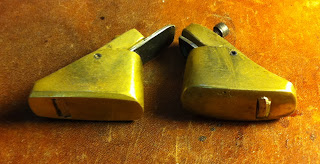One of the members of my workshop group was having the usual difficulties with some small and fine joinery, and her initial question was regarding the difficulties of accurate measurement, but the underlying issue was more searching.
She wanted to talk about the level of accuracy that she could be happy with, and she raised the issue of perfection. I had to start by saying that I don't embrace the search for perfection. I don't think that functional accuracy need be saddled with a striving for a flawless ideal, when inspired and energetic repetition is more likely to bring a quality that is much fresher, human and 'alive'.
We could spend ten years slaving to make a thing perfect or we could make dozens of things in the same period and in doing so we move our skills and our intuitive grasp of craft forward so much more. I'm not saying that big projects are a waste, because big projects are generally collections of little projects. Sometimes though, we need to look at the big goals rather than the problems which are in our faces. For me, making something is more about learning to make than it is about the product, at least if I'm to do more than simply manufacturing.
This attitude is hard to explain and I'm certainly not advocating shortcuts or shoddy workmanship. A really lovely piece of work will often appear easy, effortless and coherent.
If we start a piece thinking that it will only be good in the absence of mistakes we ignore the positive qualities that give rise to that beauty.
A curve, a shape or a cut can be a sweep of the hand that may reveal confidence and energy. This is what I aspire to, and the approach is intuitive rather than logical. And it takes lots of practice to make this kind of progress.
Someone in a hurry to achieve this would do well to use cheap materials as practice platforms for a specific skill, continuing to repeat the process until work can be done with less thinking and more feeling, more confidence and less anxiety about getting it right.
After all, this is precisely what musicians have to do to sound fluid and beautiful. The hands need to be taught how to act without conscious thought to a certain degree, through repetition. This frees the senses to concentrate on more specific perceptions.
Perfection is really akin to Plato's pet concept in which he argues that our worldly existence can be likened to a shadow cast on the walls of a cave and seen by someone who has never been able to look at the real world outside. If they have only seen the shadows then the shadows seem real, so how can they possibly imagine the 'real' world? That person's shadows are our reality, and Plato wanted us to imagine the ideal world beyond our 'cave' walls. He would argue that everything and everyone has an ideal form and structure (and behaviour?) and we live and create to approach those ideals.
Despite what I've said about perfection for me as a goal in work, I do fit into the idealist mold with regard to life and design- I always feel we can do things better if we are honest and thoughtful, and when designing something I'm always interested in finding the 'essential' forms and removing the complications that obscure them. Functional modernism is an expression of that.
 |
| The design for these small planes was very much a conscious attempt to find an ideal form. |
All of this thinking about idealism in design caused me to search out these old drawings from forty years ago in 1978. I wanted to make a methane digester to produce gas for cooking or powering a generator, particularly one that might be useful in agriculture to improve the compost value of animal waste, and to generate gas for domestic or farm use.
At the time there were interesting methane plants in India and China (hotter places, generally), but they were often messy and cumbersome designs that were labour intensive to build and use. That taste for the ideal caused me to try for a more rational design that might be manufactured in stackable modules.
Needless to say this idealistic boy in his 20's had neither the resources nor the money to do anything much with the idea, but I was fascinated with what we then called 'appropriate technology'. I noticed recently there is finally a company producing good manufactured small scale digesters- with the benefit of modern plastics, manufacturing methods and crowd funding. (I'm tempted to buy one)
 |
| From 1978, my design for a batch-fed, solar heated Methane digester, manufacturable in concrete. There are other sheets which compute inputs, outputs, volumes and carbon to nitrogen ratios. |
 |
| thermo-syphoned solar heated water was integrated into the design to maintain an optimum digesting temperature in temperate or cool climates/seasons |
 |
| On sloping sites the design allowed 'stacking', maintaining the optimum solar angle for that lattitude |
 |
| I had a concrete company keen to manufacture a prototype, but I had no funds to develop the concept further. |
















